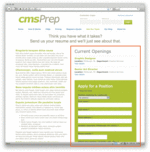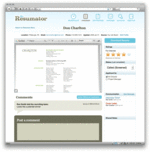HR Technology for the Small Business - Core HRIS
This installment in the occasional series on HR Technology for the small business highlights some options available to the small business (typically less than 500 employees) in the 'Core' Human Resources Information Systems market.
These are the systems that store the demographic, work history, and sometimes payroll and benefits information on your employees. They form the backbone of your HR Technology platform and strategy.
There is no shortage of competitors in this space, and the below list is by no means exhaustive or a recommendation or endorsement for any particular solution. This is just a place to start, and a jumping-off point in understanding some of the different solutions and technologies that are available. Your business has it's own unique set of requirements, constraints, challenges etc. that have to be carefully evaluated before making any decisions on core HRIS.
Larger Vendors
Sage Abra is probably the best known solution in this space. They claim to be the leading provider of HRIS in the less than 1,000 employee market. Sage has a very robust offering including employee demographics, benefits, compliance related reports, employee skills, Employee self-service, education and leaves.
Sage also has a Payroll module which is fairly uncommon in solutions targeted to small business. This solution includes support for tax updates, check printing, and direct deposit. The tight integration of Sage Payroll with Sage HR would make the consideration of Sage Payroll attractive for a small business interested in keeping or bringing payroll processing in-house.
Sage customers can deploy the software internally on their own servers, or via a hosting arrangement with an authorized provided. Pure SaaS does not appear to be offered at this time, which might make Sage not a viable option for the very small business, or a business that is not in position for a largish initial capital outlay for software licensing.
Spectrum's offering is named iVantage®, an HRIS that tracks everything from initial application through retirement. This complete HR system includes the key functions such as Absence Tracking, Performance Management, Self-Service, Time and Attendance, Workflow automation, and advanced reporting. iVantage does not have its own payroll engine, but does support the export of data to any of the likely Payroll providers a small business is likely to use (ADP, Ceridian, Paychex, among others).
In fact, iVantage's reporting tool is quite unique and user-friendly as it allows a user to enter a query in terms like, 'Show me all the employees in New York', and the reporting engine is sophisticated enough to interpret the request, and produce a report of the staff in the New York location.
Spectrum offers iVantage in three different licensing models, customer installed, Spectrum hosted, and SaaS. These options provide great flexibility to organizations in allowing them to choose the option that aligns best with their budget, IT capability, and organizational policies. SpectrumHR is a very strong player in the small to mid-sized market.
EmpXtrack is a web-based Global HR product that covers all aspects of the employee lifecycle in an organization - from recruitment to performance management, development and eventual exit. It helps automate all HR processes in the organization and provides information to all stakeholders including HR Managers, Upper Management, Managers and Employees.
EmpXTrack offers their solutions in five different 'editions', ranging from the 'Enterprise' edition that encompasses the full suite of functionality (Employee database, applicant tracking, onboarding, appraisal, succession planning, and more). Other editions of the package include the 'Starter' edition, with just the very basic employee functions, and the 'Professional' version, which adds more in-depth processes like appraisals and onboarding. Pricing is done on an annual basis based on the number of employees, and varies widely.
EmpXTrack may be a good option for an organization with numerous requirements and no real system of record. They have such a wide range of functionality, that an organization could start with just a few core functions, then add additional processes as needed.
Smaller Vendors
OrangeHRM is radically different that the other competitors in this space in one key area: pricing. OrangeHRM is an open-source project that bills itself as 'Free & Open Source HR Management Software'. Essentially, the software is free, it can be downloaded and installed on your own servers, and used by your organization at no cost. How OrangeHRM earns revenue is by selling support contracts (starting at $60 for one month of 'get on your feet' support) and by offering to host the software on their servers.
OrangeHRM supports the essential processes like employee personal information, time tracking, employee self-service (ESS), leaves, as well as recruitment. There is a reports module that allows users to define and execute ad-hoc queries on demand.
OrangeHRM might be a good option if you have internal IT resources comfortable working with open source tools or if you have an extremely constrained budget, and the cost savings by going with open source are too hard to pass up.
Zoho is better known for it's online productivity suite, that competed with Google Apps in things like word processing, spreadsheets, and presentations. They have a wide range of applications and seem to be adding more all the time. I particularly like Zoho Polls.
Zoho People is their attempt at cracking the small business HRIS market, with a simple, easy to use application that supports the basic employee demographic functions, recruiting, employee and manager self-service, and an embedded process checklist capability for things like the new hire process. Zoho People is built on the extremely flexible Zoho Creator platform, making the creation of new forms, views, and taskflows fairly simple for someone with just a bit of technical skill.
Zoho People is targeted at the very small (say 50+ employee) businesses. They offer free accounts for the first 10 employees, then from there pricing plans start as low as $19/mo for 10 employees ranging up to $850/mo for up to 1,000 employees. Realistically, Zoho is likely only an option for those very small organizations with fewer than 50 employees.
EffortlessHR is a purely web-based subscription service that targets the lower end of the small business market, up to about 250 employees. It supports the basics of employee management, time tracking, benefits information, and an employee self-service portal. The real strength of EffortlessHR for the small business is the pre-bulit support for HR forms, legal posters, and access to Federal and State labor laws.
This is definitely a small business oriented offering, particularly one with single person HR departments. The pricing is published on their site and ranges from a low of $300 annually for a single manager account, to about $1400 annually for up to 50 manager accounts. If you are a very small organization, with no HRIS in place at all, then EffortlessHR may be worth a look.
That is a quick overview of just 6 (out of probably hundreds) of options for HRIS for the small business.
I would love to hear from any other vendors or readers on other viable options that I should have featured in the post.

 Steve
Steve





